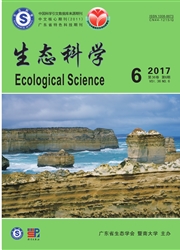

 中文摘要:
中文摘要:
对杨树中龄林、成熟林凋落物量、组成特征、季节动态及凋落物中N、P、K、Fe、Ca、Mg含量进行了定位观测和实验测定。结果表明:杨树成熟林的年凋落物量为4.45t·hm-2·a-1,是中龄林的1.42倍,两者存在显著差异(JD〈0.05);叶是凋落物的主要形式.分别占中龄林、成熟林总凋落物量的70.1%和81.5%;凋落物量具有明显的季节动态,表现为“双峰”型;成熟林养分归还量是68.4kg·hm-2·a-1,是中龄林48.96kg·hm-2·a-1的1.4倍;两林分各养分年归还量的大小顺序为N〉Ca〉K〉Mg〉Fe〉P;杨树成熟林的N、P、Fe、Mg4种元素的利用率大于中龄林的,而K和Ca元素的利用率却相反。
 英文摘要:
英文摘要:
Litterfall plays an important role in nutrient cycling and energy flow of forest ecosystems. Litterfall production, composition, seasonal dynamics, and the quantity of nutrient elements (N, P, K, Fe, Ca, Mg) of Populus tremuloides were studied in this paper. The results showed that the annual litterfall production of mature poplar (MP) was 4.45t·hm-2·a-1, 1.42 times of that for middle-age poplar (MAP). Fallen leaves dominate litterfall composition, accounting for 70.1% and 81.5% for MP and MAP, respectively. The dynamics of litterfall showed a significant seasonal variation, with the first peak occurring between February and March and the second in October or November. Annual fluxes of the 6 nutrient elements in MP was 68.4 Kghm-2a-1, which was as 1.4 times of that in MAP, and nutrient elements return decrease in the order of N〉Ca〉K〉Mg〉Fe〉P. The utilization efficiency of N, P, Fe, and Mg in MP was higher than that in MAP, but lower in MP than in MAP for K and Ca, which could be attributed to the difference in growth mechanism.
 同期刊论文项目
同期刊论文项目
 同项目期刊论文
同项目期刊论文
 期刊信息
期刊信息
